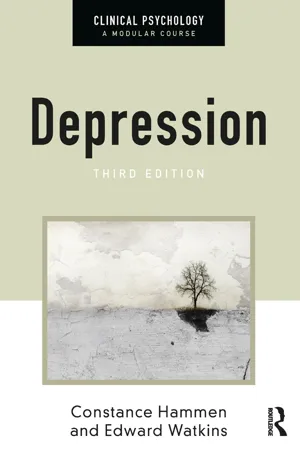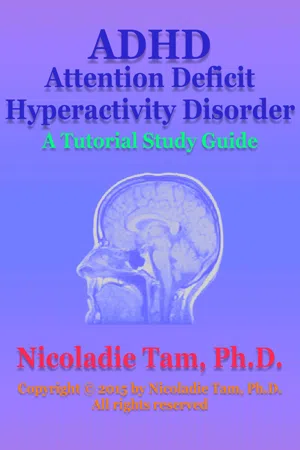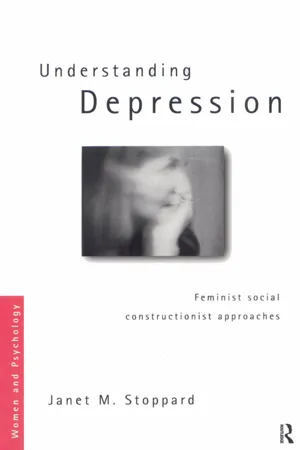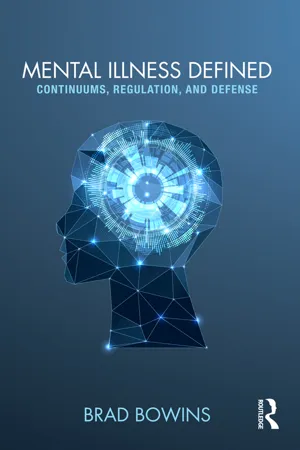Depression VS Sadness
Depression is a clinical mental health condition characterized by persistent feelings of sadness, hopelessness, and loss of interest in activities. It often involves physical symptoms and can significantly impact daily functioning. Sadness, on the other hand, is a normal emotional response to difficult situations or events and is typically temporary. While sadness is a common human experience, depression is a more severe and long-lasting condition.
8 Key excerpts on "Depression VS Sadness"
- eBook - ePub
Cognitive Behavioural Therapy for Adolescents and Young Adults
An Emotion Regulation Approach
- Lawrence Howells(Author)
- 2018(Publication Date)
- Routledge(Publisher)
...Extreme sadness can therefore lead to feelings of powerlessness and hopelessness. What is sadness? In Chapter 4 we outlined the five different elements of the emotional experience. We now consider each of these elements in relation to sadness. It is important to allow sufficient time to explore these ideas, as thinking of sadness as an emotion, and particularly a potentially useful one, is often a new idea to adolescents, young adults, and their families. Feelings Sadness is a fairly infrequent emotion, but when experienced tends to endure, often lasting for a period of days or more. Indeed, sadness appears to be the longest lasting of the common emotions (Scherer and Wallbott, 1994). Sadness is experienced as cold. It is also experienced as intense and aversive. The word “depression” derives from the Latin meaning to press down, depress. It has been adopted by the medical profession where it is used to describe the lowering of function, both in terms of activity and physiology, often seen in cases of extreme and prolonged sadness. Depression is a word that is used interchangeably between medical and emotional contexts and is sometimes given extra weight by adding the word ‘clinical’ such as ‘clinically depressed’. In this book, the word ‘depression’ is avoided as a result of its tendency to invite an understanding of emotional experience in medical terms (see Chapter 4 and Horwitz and Wakefield, 2007). This book will stick to the term sadness to ensure reference to an emotional experience. We will also avoid using the term ‘mood’ which is variously defined, but usually unhelpful in being associated with diagnosis or a value judgement about emotion. Like other emotions, sadness can be experienced to different degrees. It is helpful to encourage this perception of the different intensities of emotion, rather than just their presence or absence...
- eBook - ePub
Visual CBT
Using Pictures to Help You Apply Cognitive Behaviour Therapy to Change Your Life
- Avy Joseph, Maggie Chapman, Patrick Watkinson(Authors)
- 2012(Publication Date)
- Capstone(Publisher)
...CHAPTER 2 Depression and Sadness Depression is second to anxiety as the most commonly experienced emotional disturbance. Depression can affect us all at some point or another; women have over twice the incidence of depression than men. This is thought to be due to hormonal influences throughout a woman’s life. Here we will explore psychologically based depression as opposed to chemically or organically based depression. Types of Depression There are several different types of depression. They are usually distinguished by their dominant features, duration and severity of symptoms. Most of these kinds of depression are defined by the Diagnostic and Statistical Manual of Mental Disorders (DSM), an American Psychiatric Association publication. The following three different kinds of depression are distinct depressive disorders described in the DSM. Sufferers experience significant distress and /or impairment of functioning, e.g. work, school, relationships and so on. Major Depressive Disorder (also known as Major Depression, Clinical Depression) – A major depressive episode occurs with symptoms that last for most of the day, nearly every day for at least two weeks. Dysthymic Disorder – This is less severe than Major Depression but lasts at least two years. Bipolar Affective Disorder – also known as Manic Depression or Bipolar Disorder. This is a condition which causes mood swings. Your mood varies from excitement to depression and despair...
- eBook - ePub
- Constance Hammen, Ed Watkins(Authors)
- 2018(Publication Date)
- Routledge(Publisher)
...It is enormously impairing – and even deadly – and its effects on both the afflicted person and his or her family can be profoundly negative. Yet, we also have a number of effective treatments for depression and science is gaining considerable insight into the processes underpinning depression. Phenomenology of depressive experiences The term depression is used in everyday language to describe a range of experiences from a slightly noticeable and temporary mood decrease to a profoundly impaired and even life-threatening disorder. When used to describe a mood, the term conveys a temporary state of sadness and loss of energy or motivation that may last a few moments, hours, or even a few days. As such, it is usually a normal reaction to an upsetting event, or even an exaggerated description of a typical event (‘this weather is depressing’). A young man might feel sad for a few days following a romantic disappointment, or a woman might be discouraged for a few days upon being passed over for a job. Such experiences are not the topic of this book. Rather, the term ‘depression’ as used here refers to a constellation of experiences including not only mood, but also physical, mental and behavioural experiences that define more prolonged, impairing and severe conditions that may be clinically diagnosable as a syndrome of depression. The description at the beginning of the chapter may differ from the personal experiences of other depressed people, but all share features of the syndromes of depression. Each sufferer has features from the four different domains that define depressive disorders. The four general domains are affect, cognition, behaviour and physical functioning. Affective symptoms Depression is one of several disorders generically called affective disorders, referring to the manifestations of abnormal affect or mood, as a defining feature. Thus, depressed mood, sadness, feeling low, down in the dumps or empty are typical...
- eBook - ePub
Coping with Depression
A Guide to What Works for Patients, Carers, and Professionals
- Costas Papageorgiou, Hannah Goring, Justin Haslam(Authors)
- 2011(Publication Date)
- Oneworld Publications(Publisher)
...2 What is depression and how can you check if you are depressed? Most people have an idea of what ‘depression’ means in everyday language. We talk of feeling depressed or low in mood to describe the sadness and despondency that are a normal and common part of human experience. We might speak of feeling depressed following a disappointment, setback, or the loss of something or someone important to us. At times, however, a person’s dip in mood goes beyond such feelings of sadness or despondency into what is sometimes termed ‘clinical depression’. This involves not only feelings of despondency or sadness but a whole range of debilitating symptoms which can often be bewildering and frightening to the person experiencing them, as well as to their friends and family. It is depression in this sense that is the topic of this book. The experience of depression What is it like to experience depression? In answering this question it is important to bear in mind that no two people will experience depression in precisely the same way. Box 2.1 illustrates with two case examples some of the ways in which depression can be experienced. It typically involves feeling down, low in mood or fed-up. However, sometimes people describe instead feelings of emptiness or numbness, and for others feelings of irritability may be more apparent. It is common to experience feelings of anxiety or anger along with depression. For some people, depression is marked most by a loss of interest or pleasure in activities they previously found enjoyable. This could involve losing enthusiasm for, or interest in, work, hobbies, sex or previously enjoyed social activities. Box 2.1. Case examples of the experience of depression John, aged fifty-two, has been depressed since being made redundant five months ago. He has struggled to find another job, and has started to feel hopeless about the future...
- eBook - ePub
ADHDAttention Deficit Hyperactivity Disorder
A Tutorial Study Guide
- Nicoladie Tam(Author)
- 2015(Publication Date)
- Nicoladie Tam, Ph.D.(Publisher)
...It is the unpleasant feeling and/or the inability to experience any emotions or pleasure. The feeling of sadness is often associated with the sense of loss of things that are valuable to the person. The sense of despair in depression is the emotional state in depression that nothing can be done to alter the outcome that the person does not desire. What are the symptoms of depression? The symptoms are: daily occurrence of depressed mood diminished interest in almost all activities diminished experience of pleasure in activities significant weight loss when not dieting or weight gain insomnia or hypersomnia psychomotor agitation or retardation fatigue or loss of energy feeling of worthlessness or inappropriate guilt diminished ability to think or concentrate, or indecisiveness recurrent thoughts of death, recurrent suicidal ideation with or without a specific plan The above symptoms are often occurring most part of the day, every day or nearly every day in depressed patients. The diminished interest is characteristics of the depression in the reduced motivation to do things. The diminished ability to experience pleasurable activities is also another characteristic of depression for its inability to derive pleasure from normally pleasurable activities, such as engaging in hobbies. Different depressed person may respond differently with different coping skills. For instance, some cope by eating while others cope by not eating. Some cope by sleeping so much that they cannot get themselves out of bed, while others cope by worrying so much that they cannot fall asleep reminiscing the dreadful worries. Some cope by responding with agitation and restlessness, while others cope by responding with little motivation to do anything. The lack of energy to do anything is very common in depressed state...
- eBook - ePub
Mending a Broken Mind
Healing the Whole Person Who Suffers with Clinical Depression
- Andrew Adam White(Author)
- 2021(Publication Date)
- Cascade Books(Publisher)
...2 Different Faces of Depression W hen talking about depression, we face a problem with our nomenclature: The term depressed describes two very different problems. The word can be used for the common, mild, short-lived low moods most people experience from time to time. This same word is also used for people who are suffering from the mental illness called depression. “I am depressed” means something very different when used by people who have the mental illness called depression or, by contrast, those who do not have the mental illness called depression —those who are just discouraged. Most of the time I will be using the words depressed and depression in the sense of a mental illness. Most people have three kinds of days: mountaintop days, plain days, and valley days. On mountaintop days, everything seems to be going great; the world looks bright. Most of life, for most people, consists of plain days, when we are not feeling exceptionally great, but neither do we have the blues or feel discouraged. Overall, we are doing pretty well. Valley days are gray days, when we have the blues or experience discouragement. On a valley day, we might say, “I am depressed” and not at all imply that we have a mental illness. For people who have not experienced the mental illness called depression and are trying to understand it, it is helpful to recognize that depression is not just many gray valley days strung together. Depression, it is true, is one depressing day after another, on and on and on. The prolonged nature of the depression is part of the illness. There is indeed this quant itative component to depression. But in depression, there is also a qual itative component. For one, the mood is significantly worse than the blues or discouragement. The days are not merely gray. They are dark—sometimes pitch black. Secondly, there is a different character to the mood especially in more severe depression...
- eBook - ePub
Understanding Depression
Feminist Social Constructionist Approaches
- Janet Stoppard(Author)
- 2014(Publication Date)
- Routledge(Publisher)
...2 WHAT IS DEPRESSION? Definitional debates DOI: 10.4324/9781315787961-3 In the previous chapter, I discussed different meanings of the term depression and drew a distinction between the way mental health professionals and researchers use this word and how it is used by ordinary people. When used by professionals and researchers, the word depression normally means depressive disorder or depressive symptoms (these terms were defined in Chapter 1). In this chapter, I discuss these two ways of conceptualizing depression in more detail, considering how they are employed in practise and also examining the assumptions on which they are based. An issue of particular interest to researchers and professionals (especially those in North America) is the need to distinguish between depressive disorder and depressive symptoms. Although these two ways of conceptualizing depression can be differentiated, they also have features in common which distinguish them from a third way of understanding depression, depressive experiences. When depression is understood in this way, the perspective shifts from that of researchers and professionals to that of women who are depressed, with a focus on subjective experiences. In the theoretical approaches to Explaining Depression in Women discussed in Part II, depression has been conceptualized as either depressive disorder or depressive symptoms. If considered at all, women’s depressive experiences serve mainly as a resource used by researchers and professionals for diagnosing depressive disorder or for establishing the presence of depressive symptoms. Thus women’s depressive experiences are not of direct interest in most positivist approaches to research and professional practise. From a feminist perspective, in contrast, women’s reports of their depressive experiences are viewed as having meaning in their own right...
- eBook - ePub
Mental Illness Defined
Continuums, Regulation, and Defense
- Brad Bowins(Author)
- 2016(Publication Date)
- Routledge(Publisher)
...Chapter 2 Depression Throughout recorded history there is evidence of depression, and it comprises one of the most common conditions mental health professionals treat, supporting the position that it is a naturally occurring entity, at least for humans. However, how it is structured is debatable. Throughout the history of psychiatry there has been a tendency to view depression as consisting of discrete types. Two types have traditionally been identified: Endogenous, vital, or melancholic, and reactive, neurotic, or dysthymic (Healy, 2013; Kiloh et al, 1972; Parker et al, 1988; Paykel, 2008). Melancholia was identified at the time of Hippocrates and persisted as a diagnosis through Galenic and medieval times (Paykel, 2008). In 1621, Richard Burton wrote The Anatomy of Melancholia (in Paykel, 2008). Carl Lange, in 1880, identified a disorder with neurovegetative features that became known as endogenous or vital depression (in Healy, 2013). Psychoanalysts led by Freud were instrumental in advancing the notion of reactive depression, in which the actual or symbolic loss of a love object gives rise to depression (in Shorter, 1997). According to Alfred Meyer all psychiatric illness consists of a psychobiological reaction to stress (in Paykel, 2008). Discrete endogenous and reactive forms of depression are consistent with the medical disease model, whereby distinct con-ditions demonstrating etiological, symptom, course, and treatment differences occur (Paykel, 2008). The alternative—the unitary perspective maintaining that depression is a single entity with various manifestations—aligns with the overlapping features of depression (Parker et al, 1991; Parker, 2013). Diagnostic systems such as the Diagnostic and Statistical Manual (DSM) and the International Classification of Diseases (ICD) have proposed discrete forms of depression—understandably, given that the disease model is the basis for these classification systems...







